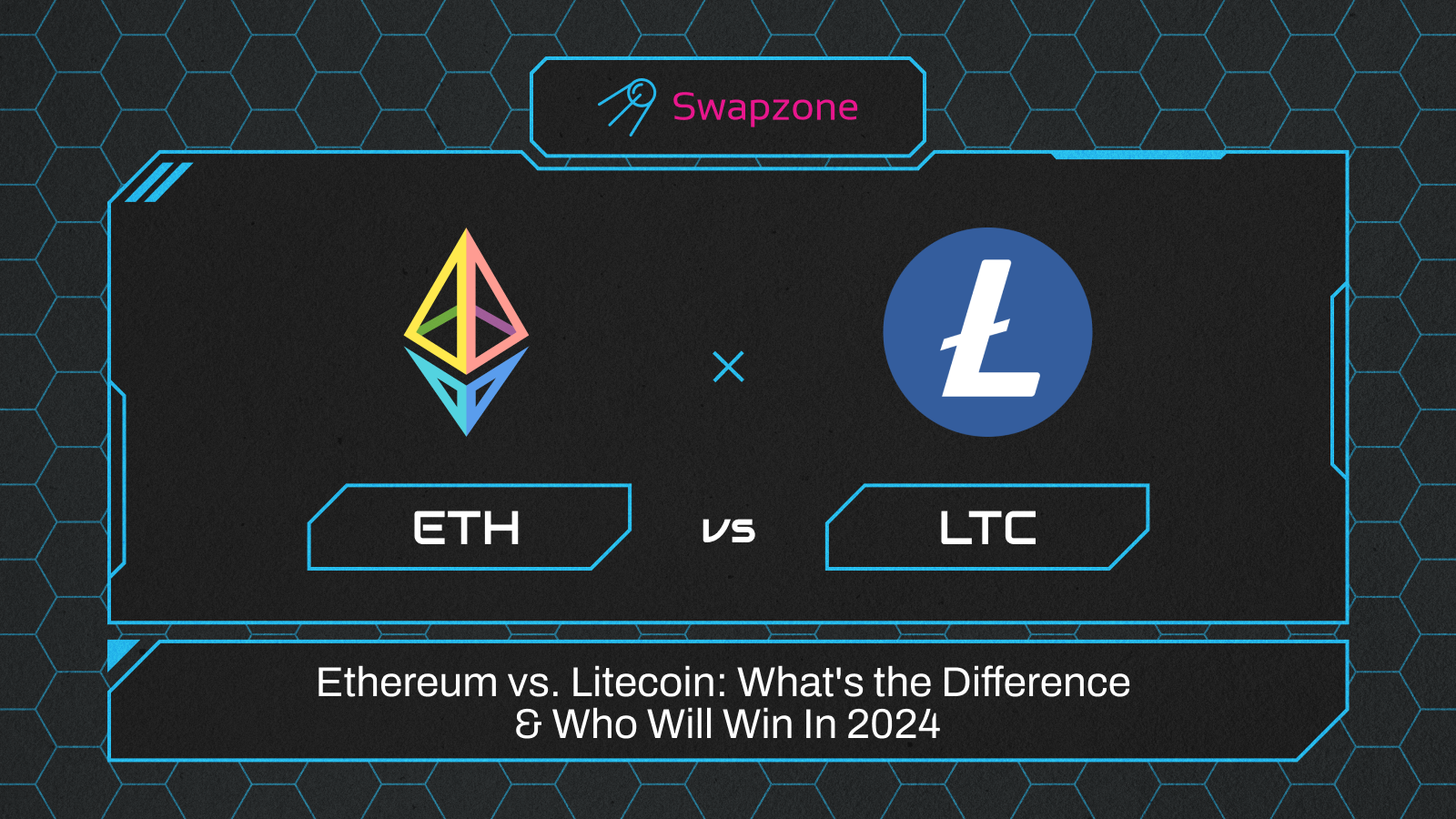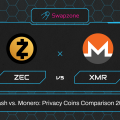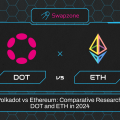Welcome to this guide, where we aim to unpack the difference between Ethereum and Litecoin. As part of the ever-expanding realm of blockchain technology and cryptocurrencies, understanding the nuances of these digital assets is essential for any enthusiast or investor.
Throughout this guide, you will get the explanation of Ethereum‘s groundbreaking smart contract capabilities. Also, its historical evolution, and the influence of the Enterprise Ethereum Alliance. In contrast, we will explore Litecoin’s history, the motivation behind its creation by Charlie Lee, and its unique positioning in the crypto market.
You will have a comprehensive understanding of these two coins. Let’s dive into features that set Litecoin and Ethereum apart in the exciting world of decentralized finance and blockchain innovation.

What is Ethereum?
Ethereum is a decentralized platform that enables the creation of smart contracts and decentralized applications, or dApps, through its blockchain. Launched in 2015, Ethereum uses a crypto called Ether (ETH) to facilitate transactions and incentivize Ethereum network participants, such as developers and miners.
ETH is currently one of the largest cryptocurrencies by market capitalization. Some consider, “it’s way ahead of where PayPal was in its day” (Gil Penchina). Ethereum’s programmable nature allows developers to build various applications on its platform, from decentralized finance (DeFi) protocols to non-fungible token (NFT) marketplaces.
This flexibility and innovation have positioned Ethereum as a key player in the blockchain space, driving advancements in areas like decentralized finance, supply chain management, voting systems, and more.
Smart Contracts
Smart contracts find diverse applications, ranging from enabling initial coin offerings, or ICO. They’ve been used for fundraising and for safe and clear property sales in real estate transactions. These programs, leveraging programmable money through utility tokens and security tokens, exemplify the versatility of smart contracts in revolutionizing financial processes and fostering trust in various sectors.
Ethereum’s Background
Ethereum was created by Vitalik Buterin and funded through ICOs. Ethereum Foundation oversees its development and Ether cryptocurrency. The ICO went through versions like Homestead and Metropolis. In September 2022, Ethereum shifted from Proof-of-Work to Proof-of-Stake consensus mechanism. The upgrade is also called Ethereum 2.0, Eth2, or Serenity.
Enterprise Ethereum Alliance
The Enterprise Ethereum Alliance (EEA) is a group of companies like:
- Toyota,
- Samsung,
- Microsoft,
- JP Morgan,
- Intel,
- Deloitte.
EEA explores the potential Ethereum applications in various industries. Their collaboration boosted Ether’s usage in industries. EEA members aim to harness Ethereum’s capabilities for diverse business needs, driving innovation and adoption of Ethereum blockchain across sectors beyond finance.

What is Litecoin?
Litecoin is a digital currency designed much like Bitcoin. It operates on an open-source platform, allowing anyone to use and contribute to its development.
Litecoin is faster than Bitcoin in terms of transaction confirmation times, making it a more efficient payment system. It employs a decentralized approach to mining, where individuals can participate in the network and earn Litecoin through the process.
History of Litecoin
Litecoin, launched by Charlie Lee as a Bitcoin fork, drew inspiration from his earlier project Fairbrix and the currency Tenebrix. It introduced innovations like:
- Segregated Witness (SegWit);
- Lightning Network;
- Atomic swaps.
Litecoin’s dynamic relationship with Bitcoin includes serving as a test network for software upgrades. These advancements highlight Litecoin‘s role in exploring and adopting cutting-edge technologies within the cryptocurrency landscape.

Litecoin vs. Ethereum: Comparing Technologies
Litecoin and Ethereum differ fundamentally in their technologies and purposes. Litecoin, compared to Bitcoin, primarily serves as a payment system with quicker transaction times and block generation.
In contrast, Ethereum operates as a decentralized computer system, supporting decentralized applications (dApps) through smart contracts. While Litecoin focuses on efficient and fast transactions, Ethereum’s versatility lies in its ability to execute complex smart contracts, making it a platform for decentralized applications.
The time of new blocks and transaction speeds reflect their distinct design philosophies. Litecoin prioritizes speed for transactions. Whereas Ethereum emphasizes a broader range of decentralized functionalities beyond mere transactions. The choice between them depends on specific needs, with Litecoin excelling in straightforward transactions and Ethereum offering a more comprehensive decentralized computing platform.
Key Difference Between Ethereum and Litecoin
| Ethereum | Litecoin | |
| Total Supply of Coins | 120,093,479 ETH | 84,000,000 LTC |
| Current Available Supply | 120,093,479 ETH | 74,301,637 LTC |
| Average Transaction Cost | $2.3 | $0.04 |
| Average Block Time | 12 Seconds | 2.5 Minutes |
| Consensus Mechanism | Proof-of-Stake Algorithm | Proof-of-Work Algorithm |
| Primary Use | Smart Contracts, dApps | P2P payments, a store of value investment |
| Founder | Vitalik Buterin | Charlie Lee |

Litecoin vs. Ethereum: Mechanism
Litecoin relies on the Proof-of-Work (PoW) consensus mechanism. The mechanism is shared with Bitcoin and requires miners to solve intricate mathematical problems for transaction validation. In contrast, Ethereum in 2022 transitioned from PoW to Proof-of-Stake (PoS), known as the Ethereum Merge or Ethereum 2.0.
In Ethereum’s PoS, validators secure blocks by staking their coins, promoting Sybil protection. This shift aims to enhance scalability, reduce energy consumption, and improve environmental sustainability compared to PoW. While Litecoin and Bitcoin continue with PoW, Ethereum embraces PoS as an eco- and environmental-friendly mechanism. The consensus works by reducing energy consumption and improved scalability compared to PoW.
Each approach has its merits, reflecting the diverse strategies within the cryptocurrency landscape as it strives to balance efficiency, security, and sustainability. The continued exploration and adoption of innovative consensus mechanisms contribute to the dynamic and ever-evolving nature of blockchain technology.

Litecoin vs. Ethereum: Programming Language and Virtual Machine
Litecoin vs Ethereum differ in their programming languages and virtual machines.
| Ethereum Programming Languages | Litecoin Programming Language |
| Solidity Yul | C++ |
Solidity and Yul are applied for crafting smart contracts on the Ethereum Virtual Machine (EVM). In contrast, Litecoin applies the C++ programming language and lacks a dedicated virtual machine, restricting its programming complexity.
Solidity and Yul enable Ethereum to provide a robust platform for decentralized applications through sophisticated smart contracts. Litecoin uses C++, thus offering simplicity but with limitations. Regarding programming intricacy and versatility, it lacks a dedicated virtual machine. These distinctions highlight the unique approaches each blockchain takes in supporting programmable functionalities.

Litecoin vs. Ethereum: Decentralization
Litecoin and Ethereum exhibit contrasting degrees of decentralization. Litecoin operates with inherent decentralization, primarily maintained by miners. In contrast, developers and validators of Ethereum centralize its structure with their ongoing maintenance.
While both platforms prioritize decentralization, Litecoin relies heavily on its mining community. And Ethereum’s governance involves a broader network of stakeholders, including developers and validators. It reflects differing approaches to achieving decentralization within the blockchain ecosystem.

Litecoin vs. Ethereum: Transaction Fees
In terms of transaction costs, Litecoin and Ethereum offer different fee structures. Ethereum employs gas fees to measure the computational effort required to transact crypto. It results in variable costs based on network activity. On the other hand, Litecoin generally maintains a lower average transaction fees. It is due to its incentivized structure for miners, where transaction fee serve as rewards.
This setup positions Litecoin as a more cost-effective option for day-to-day transactions, unlike Bitcoin, known for its higher transaction fees. The distinct fee models cater to various user needs within the cryptocurrency space. That provides flexibility and choice for individuals looking to engage in digital transactions with varying fee preferences and priorities, driven by the concept of incentives.
Transaction speed: Litecoin vs. Ethereum?
Ethereum typically offers a faster transaction speed than Litecoin. Ethereum’s block time is 12 seconds, which is shorter, compared to Litecoin’s 2.5 minutes. However, factors such as network congestion and mining can influence transaction speeds on both platforms.
While Ethereum’s quicker block time initially suggests swifter transactions, Litecoin’s slightly longer block time can still provide efficient and reliable transaction processing. Ultimately, the transaction speed difference between Litecoin and Ethereum showcases varying approaches to transaction validation and network efficiency, catering to different user preferences and use cases within the cryptocurrency ecosystem.
Ethereum vs Litecoin: For Payments?
In the realm of payments, Litecoin and Ethereum present different strengths and considerations. Litecoin’s streamlined focus on transactions and faster block generation times make it more suitable for quick and efficient payments. Its simpler design and lower likelihood of network congestion provide reliable transaction processing, ideal for everyday payment needs.
Ethereum offers faster confirmations due to shorter block times. However, it can experience network congestion during high dApp activity, leading to transaction delays. For example, this was seen during events like the CryptoKitties craze. Ethereum’s versatility in supporting complex decentralized applications (dApps) broadens its utility beyond simple payments but may encounter challenges during peak usage periods.
Ultimately, the choice between the two for payments depends on the specific requirements of the transaction, balancing speed, reliability, and network capacity to determine the most appropriate option for the intended payment use case.
Ethereum vs Litecoin: The Prices?
The prices of ETH and LTC are influenced by their market capitalization and circulating supply. Market capitalization represents the total value of all coins in circulation, while circulating supply refers to the number of coins available for trading.
Visual representations from CoinMarketCap showcase the distinct market cap and circulating supply figures for both, highlighting how these factors impact each cryptocurrency’s price valuation. Understanding these metrics is crucial for investors and traders to gauge the relative value and potential growth of ETH and LTC in the dynamic cryptocurrency market.
By examining market capitalization and circulating supply, stakeholders can make informed decisions based on the comparative pricing and market positioning of these two prominent digital assets.
Litecoin vs. Ethereum: dApp and NFT support
When comparing support for decentralized applications (dApps) and non-fungible tokens (NFTs), Ethereum excels as a dominant player in both realms. Most developers prefer Ethereum for dApp development, given its robust ecosystem and smart contract capabilities. In the NFT market, Ethereum leads with a wide range of NFT projects.
While Litecoin also supports NFTs, like Ordinals introduced in February 2023, Ethereum’s established presence in these areas sets it apart. Both coins offer strong networks and coins. But the decision between them hinges on user activities and objectives within the evolving web3 landscape. Ethereum’s dApp support and NFT support remains a prominent choice. Developers and enthusiasts seeking advanced decentralized functionalities, particularly in areas related to payments and innovative blockchain applications.

Litecoin vs Ethereum: Conclusion
In summary, Litecoin and Ethereum showcase distinct features and purposes within the crypto landscape. Litecoin excels in efficient payments with lower transaction fees. While Ethereum stands out for its advanced smart contract capabilities and decentralized application support. It’s essential to recognize that these two cryptocurrencies are not in direct competition but cater to varied user needs and preferences.
As you explore the future potential of Litecoin and Ethereum, recap their historical evolution, technical differences, and unique strengths in the crypto market. Both cryptocurrencies offer promising opportunities for growth and innovation. Litecoin and Ethereum encourage users to assess their individual goals and requirements. Users leverage the strengths of these coins effectively in their digital endeavors.
Frequently Asked Questions
Choosing a better crypto, Ethereum and Litecoin involves considering their specific use cases. Litecoin focuses on peer-to-peer payments, while Ethereum supports complex transactions and decentralized applications (dApps). Both cryptocurrencies offer potential returns on investment (ROI), subject to market conditions. Ethereum’s dApp support may attract those seeking innovation, while Litecoin’s focus on efficient payments appeals to specific needs. Ultimately, the choice depends on individual preferences and goals within the cryptocurrency market.
Ethereum leads with over 1,600 dApps, fostering a vibrant decentralized development ecosystem. Utilizing tools like Solidity, Ethereum offers a prime environment for diverse dApp creation and deployment, drawing developers and users seeking cutting-edge blockchain solutions. While Litecoin also supports dApps, Ethereum’s extensive infrastructure positions it as the premier platform for decentralized application development and adoption.
In terms of transaction speed, Litecoin generally processes transactions faster than Ethereum. Litecoin’s block time is 2.5 minutes, while Ethereum has a 12-second block time. This means that Litecoin transactions are confirmed more quickly compared to Ethereum, making it faster for payments and transactions.
Deciding whether to invest in Litecoin or Ethereum depends on personal preferences and goals. Ethereum offers a broader range of utility with its smart contracts and decentralized applications. Litecoin, known for efficient payments, may be favored for its simplicity. Researching both and assessing your investment strategy is recommended.
Investing in Ethereum or Litecoin for the long term depends on your risk tolerance, investment goals, and research into the cryptocurrencies. It’s recommended to consult with a financial advisor and conduct a thorough analysis before making any investment decisions.


